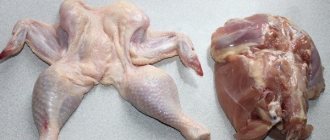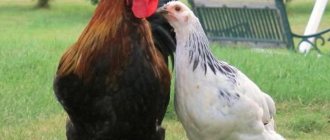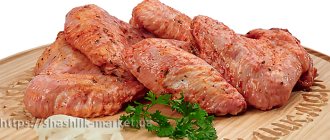If cutting up a chicken is still something supernatural and incredibly labor-intensive for you, then stay with us. Now we will tell you all the secrets that will allow you to carry out this work in the kitchen in the literal sense of the word in one, two, three times. This type of cutting of a chicken carcass allows you to quickly separate the flesh from the bones, remove the skin and prepare the product for cooking. Depending on production needs, the housewife will be able to simultaneously make preparations for second courses and leave the bones for cooking a tasty and aromatic broth.
The proposed chicken cutting scheme is approved by the technological maps of most restaurants and cafes. When using it, minimal waste is obtained.
How to choose a chicken
It's better to buy chilled chicken. So you will pay only for the weight of the carcass itself: unscrupulous producers pump chickens with water before freezing to increase weight. In addition, the freshness of chilled meat is easier to determine.
Express check of freshness of chilled chicken:
- Examine the chicken. If there are scratches or bruises on the carcass, the skin is damaged or has yellow-gray spots, it is better to refuse the purchase.
- Pay attention to the color. The age of chickens is determined by skin color. In young ones it is soft pink, with distinct veins. The skin of an old chicken is thick with a yellowish tint.
- Touch the carcass. Press your finger on the breast: fresh meat is elastic, it will quickly return to its previous shape. If a dent remains after pressing, this is a sign of damage to the product.
- Smell the carcass. Fresh chicken just smells like raw meat. Avoid buying chicken that smells like medicine or other off-flavors.
How to cut chicken into portions
Prepare everything you need:
- Chicken carcass. It needs to be washed and dried with paper towels.
- Cutting board.
- Sharp knife. Big or small - your choice. The main thing is that it is well sharpened.
- Bowls or bags for laying out meat.
Chicken meat is white and quite dietary (twice as much protein as fat). The carcass consists of the neck, back, breast, wings, thighs and drumsticks. In stores, as a rule, chickens are sold already plucked, without heads and necks.
Wings and legs are used for frying or stewing. The breast is used to make cutlets and chops, and the boiled breast is added to salads. The back, along with scraps of skin, tail and other non-format meat, goes to the broth.
To cut a chicken quickly and without problems, there is one golden rule.
Cut at the joints! Don't try to saw the bones.
First, separate the legs. They can be used whole or cut into thighs and drumsticks. Then cut off the wings. The first phalanx of the wing is usually separated and used to prepare broth, since there is little meat there and this part burns when frying.
Then cut out the breast. Make an incision along the chest ridge, pressing the knife against the bone. Then, using your fingers to help you, carefully cut the meat from the frame. After this, separate the second half of the brisket from the back.
The remaining frame can be broken into several parts to make it easier to store and cook.
Once you get the hang of it, this whole process will take you no more than 5–10 minutes.
Video
The best way to understand how to cut a chicken is to watch the video.
Gutting
Cutting
A whole chicken carcass is cheaper than ready-made processed parts. But then the question arises - how to cut a chicken? If done incorrectly, all the meat can be ruined. If the intestines, gall bladder or spleen are opened, the meat will acquire a specific smell and will be bitter. Let's figure out how to quickly disassemble a carcass for different purposes.
Tools: a well-sharpened knife, dishes for storing waste and giblets, a cutting board. The pre-plucked bird is placed on its back and work begins.
To gut and cut chicken you will need a well-sharpened knife.
The evisceration process has several stages, one after another:
- Cutting off paws. To do this, stretch the tendons (bending the knee joints) and cut them with a sharp knife. There is no need to press hard; cut carefully.
- Cutting the skin around the anus. Make the cut carefully and shallowly so as not to touch the internal organs.
- A skin incision in the center of the abdomen. How to do this correctly? We cut the bird in half, from the keel to the anus. The depth of the incision is exactly to the film enveloping the intestines. Again, ensure the integrity of the internal organs. If you are a beginner separator, it is better to tear off the remaining fabric by hand.
- Following this, the intestines, along with the anus, are removed and thrown away.
- Then you need to make cuts to separate the stomach and liver. They will then become components of dishes. The main thing is not to crush the spleen at the same time. It is then cut off, outside the carcass, and placed in a trash bin.
- Goiter extraction. The best option is if the bird was not fed before slaughter. In this case, remove the crop along with the esophagus. In another, cut the neck before gutting. Empty the crop thoroughly. Then disassemble the chicken further. If the bird is killed internally, the neck will also have to be cut - otherwise the crop will not be removed.
All incisions are made carefully so as not to damage the internal organs.
If you are dressing a rooster, remove the testes (yellow glands) by pulling them out of the tail through a gentle cut. The chicken's ovaries are also removed. The lungs and heart are removed at the very end of disassembly.
The stomach is emptied additionally: an incision is made, then it is turned inside out, the remaining food is removed and the inner rough layer is disposed of. At the end of gutting, the body of the bird and the offal are thoroughly washed. It is best to do this under running water.
Important. Gutting should be started as soon as possible after plucking - in order to avoid processes that are destructive to the meat, starting in the intestines or crop, and spreading to the meat. Having completed gutting, you can begin cutting.
How to cut chicken for roll and stuffing
Whole chicken roll is a delicious dish for a holiday table. It can be boiled in cling film (you get something like chicken ham) or baked in the oven with mushrooms, vegetables, dried fruits and other fillings.
In any case, all bones must be removed from the carcass. Here's how it's done:
To prepare stuffed chicken, bones are also often removed. Only in this case an incision is not made along the sternum. The carcass is gradually turned inside out, while the thigh bones are carefully removed and the meat is separated from the frame.
Baking
You can easily dry out a chicken breast here. But still, in the oven it will turn out more interesting than just boiled in water.
Take the breast, sprinkle with your favorite spices, add a little salt, wrap in foil (optionally in a baking sleeve) and put in the oven at 150 degrees. After 5-10 minutes in the oven, increase the temperature to 170-180 degrees. And bake for another 15 minutes.
The main thing is not to overcook the chicken in the oven, so it’s better to turn on the timer.
Cutting up the chicken
You can bake a whole chicken for a holiday table or family dinner. But more often in the kitchen you need pieces of chicken from which you can prepare many dishes. Next, we'll talk about how to cut up a chicken so that it's quick and economical. For general clarity, you can use the instructions from the video (by Edim TV).
- Place the whole chicken so that the breast is on top. Grasp the chicken leg and pull it to the side. Now you need to cut the skin in the place where the inner thigh connects to the torso.
- Now you need to separate the joints of the bones. Turn the leg out, holding the carcass with your other hand. Once the femur is out of the socket, the stem can be easily removed using a knife.
- If desired, you can divide the leg into two parts: drumstick and thigh. As in the previous point, you need to feel the joint and cut along it.
- It's time to separate the wings. You need to feel the joint that connects the body and the wing, and make an incision in this place.
- Place the chicken on its side to remove the breast and back portions. There is a fatty stripe on both sides along the body, and this will become the incision line. Cartilage and ribs are hidden underneath, so cutting will be easy. You need to cut from the back to the front.
- Now we have the back, which is useful for broth, and the breast on the bone. To separate the fillet, you need to feel the cartilage in the middle and cut it out. Then turn the breast over, lift the flesh with your fingers and carefully remove it from the bones.
We hope you can now cut up chicken without any difficulty. Below are detailed photo instructions to make the process of cutting a carcass even clearer.
How to economically separate meat from bones?
If you want to make a chicken roll or prepare ground chicken, you will need to separate the meat and bones. At first glance, there is nothing difficult about this, but if you do not have experience, cutting chicken can take a lot of time.
- Place the chicken breast side down. To remove the spine, make two longitudinal cuts on each side. During the process, trim the meat with a knife so that nothing remains on the bone.
- Remove the spine and make cuts around the bone that holds the breast. You will also need to cut off the cartilage near the shoulders, after which the bone will be removed without problems.
- Now you need to get the femur. First, cut off the small bone that connected the leg to the body. Then use your fingers and a knife to free the second bone from the pulp.
All that remains is to trim the wings and you're done. Now we have a whole boneless chicken. If you do not need to leave the carcass whole, then use the following video tutorial (by Super Bluda).
Don't worry if you don't get the meat off quickly the first time. As in any business, it requires skill, which comes with experience. But minced meat prepared at home will probably be better than store-bought. And whole boneless chicken can be used in various recipes: rolls, stuffed carcass or just fried flesh will suit your taste.
Instructions for creating portions
Let's figure out how to disassemble the bird into portioned pieces step by step.
Usually it is cut into six, eight or ten pieces - in proportion to the number of people at the table and the desire to make them larger or smaller. If the whole carcass is already ready, its legs and thighs can be served as whole legs, and the breast will yield two or four servings. The starting point here is the size of the carcass, because a young and small chicken will yield a maximum of four pieces.
Poultry is cut at the joints of the bones (joints), which requires understanding where they are located. Then cutting off the wings and legs from the backbone will be quite easy. For proper cutting, it is best to choose a sharp knife with a large blade. Housewives often use special culinary scissors: such cutting does not require strong physical force.
Portion cutting can be useful, for example, for chicken kebab. This will require some time and skill.
When cutting into portions, you get 6-8 pieces.
So, step by step instructions:
- Step 1. Standard. Wash the bird and place it on its back.
- Step 2. Cut off the wings with a well-sharpened blade. The tip of the wing, which has virtually no meat, can be cut off and discarded.
- Step 3. Cut off the legs. Separate the drumstick and thighs. The leg of a large bird can yield four servings.
- Step 4. The breast will also make four pieces. Before cutting it is cut off from the ridge.
The back and throat are not suitable for this dish.
Attention. You need to string the portions onto the skewer carefully, parallel to the bone, and place them quite tightly.
Secrets of famous chefs
Professional chefs know many secrets of food preparation and cooking, including how to easily cut up chicken. We will share some tricks with you. The chef of the EdaHDTelevision channel will tell you about the subtleties of cutting chicken for rolls.
A good working tool plays a big role in the cooking process. So, to cut a chicken carcass you need to take a large knife, but it will be more convenient to separate the flesh from the bones with a small but sharp knife. Also, many culinary professionals use kitchen scissors with a serrated blade to cut chicken.
Removing Skeletal Bones
Cutting chicken from the bones is required for preparing rolls and other semi-finished products:
- Make a cut along the ridge. Place the chicken breast side down on a cutting board. Using poultry shears or a chef's knife, make a cut along one side of the spine. Uncover the chicken, being careful not to damage or tear the skin.
- Removal of skeletal and spine bones. Make a cut on the other side of the ridge and remove it. Discard the backbone or save it for broth.
- Flatten the chicken. Turn the chicken breast side up, opening the cavity so the chicken lays as flat as possible. With one hand on top of the other, press firmly on the breastbone area to break the breast bone and completely flatten the bird. You should hear and see the chest bone break.
- Secure the wings. Bend each wing away from the body and secure its end under the cervical region.
Watch how chicken is cut in the video, which illustrates the production process:
What comes before cutting?
Before hitting store shelves and tables, a chicken carcass goes through several stages of preparation. The following are produced sequentially:
- slaughter A fattened chicken is caught by the legs, placed in a confined space, and given water to completely cleanse the intestines. The bird is then killed by electrocution or mechanical means (cutting off the head or cutting the arteries);
- bleeding. The bird's body is hung upside down so that all the blood drains into the prepared container;
Bleeding a chicken carcass before plucking
Plucking chicken at home
Why is it so important to learn how to properly cut up a chicken?
The quality of carcass processing directly affects the taste of the meat. If the intestines or spleen are touched during gutting, the organ fluid will flow out and be absorbed into the pulp. Such chicken will have an unpleasant odor and bitter taste.
The quality of carcass processing directly affects the taste of meat
In addition, professional cutting skills allow you to use parts of the carcass as economically as possible. Knowing the nuances, it is easy to make preparations for a soup set, meat for frying, baking, salads, separate fillets for minced meat and pieces for feeding animals. For farmers, this is also an undeniable plus, since semi-finished products sell better than whole chickens.
Dressed chicken is easier to sort and store
Proper cutting is also rational from the point of view of allocating space in the refrigerator and freezer. The carcass takes up a lot of space, while even pieces are easily laid out like “Tetris”.
Finally, an organized, streamlined process takes less time and stress. Perfected movements are performed quickly, a minimum of waste eliminates lengthy cleaning.
Chicken chops in a frying pan, proven recipe with photos
The most delicious and tender, of course, are chicken chops in a frying pan in the classic execution. A proven recipe with photographs will reveal in detail the sequence of creating a delicious masterpiece of juiciness from chicken fillet.
Ingredients:
- chicken breast – 400 g;
- chicken eggs – 3 pcs.;
- wheat flour – 130 g;
- spices – 0.5 tsp;
- salt – 0.5 tsp;
- garlic – 4 cloves;
- mayonnaise – 60 g.
Cooking chicken chops in a frying pan. Proven recipe with photos
Remove the skin from the chicken breast and cut out 2 fillets. Rinse and dry the meat.
Cut each fillet into slices 1.5 cm thick. Cover the meat with cling film and beat lightly with a hammer. Remove the film, turn the pieces over and repeat the procedure.
Rub the resulting chops with chicken spices and add salt if necessary.
Then fold into a wide container with high sides. Peel the garlic, wash it, chop it with a knife, mix with mayonnaise. Rub this mixture onto the chicken chops in the pan. It will be convenient to pour them in a bowl so that the chicken slices are wet on all sides in the sauce. Leave the chicken chops to marinate in a cool place for 15-30 minutes.
Meanwhile, prepare the batter for the chicken chops in a frying pan.
First option
- Break the eggs into a bowl and beat them with a fork or whisk until fluffy. Pour flour into another flat container.
Second option
- Break the chicken eggs, add flour. Beat everything with a mixer or whisk until smooth.
Heat a deep, wide frying pan with a thick bottom, preferably cast iron. Pour out the vegetable oil.
First roll the marinated chicken meat in egg wash.
then - in the flour mass.
Place in a frying pan with very hot oil.
Fry chicken chops in a frying pan for a minute over high heat on both sides. Then reduce the heat and fry the meat for another four minutes on all sides.
If you used the second version of the batter, then you just need to thoroughly bathe the slices in the egg-flour mixture and place them in a frying pan. Fry chicken breast chops as usual, as suggested above.
Chicken chops prepared in this simple way in a frying pan will turn out to be the standard of tenderness and juiciness.
This appetizing dish will impress with its flavor palette. Thanks to the marinade, neutral chicken meat will acquire not only juiciness, but also a pleasant piquancy. Thanks to the batter, the chicken breast chops will retain their juicy qualities and will be incredibly crispy. This dish will perfectly complement a family dinner or a whole feast.
Preparation for cutting
Before starting work, you need to prepare tools and space. Gutting is a rather dirty process, so it is preferable to cover the surface of the table, surrounding equipment and furniture with oilcloth. It is advisable to protect your clothes with an apron and put on cellophane or rubber gloves on your hands.
For the operation you will need:
- board. It is better to use an option made of flexible or hard plastic. Wood absorbs all odors and juices, and glass may not withstand pressure. If you choose a wooden option, you should wrap the device in cellophane or use a board exclusively for cutting meat;
For cutting, it is best to choose plastic cutting boards.
Professional knife for cutting and gutting poultry
Gutting fork
Chicken cutting tool set
Prices for meat cutting knives
This set is considered ideal, but you can get by with a couple of knives of different sizes. Tools must be well sharpened and washed before starting work.
When the tools are collected, the final stage of preparing the carcass is carried out:
- Amputation of head and paws. If decapitation is not carried out during slaughter, it is easier to carry out with a culinary or household ax. The paws are cut off along the tendon near the lower cartilage or also chopped off;
Before gutting, the paws and head are removed from the carcass
Tools that will come in handy
To quickly and conveniently pack chicken, you will need the following tools:
- Cutting board. This kitchen accessory differs in material and its strength, ability to absorb juices and odors. Based on these criteria, wooden objects that quickly absorb meat juice and odors are not suitable for cutting chicken. It is recommended to use bamboo, plastic or silicone surfaces that resist the growth of bacteria, do not absorb odors, and are not afraid of moisture. If the cook only has a wooden board at his disposal, it should be wrapped in durable film before work.
- Dishes. To cut chicken, you will need any convenient container - a dish, bowl or pan for storing the separated parts of the carcass.
- Chef's scissors. This tool is included in the mandatory list of kitchen utensils needed for cutting poultry and preparing portioned pieces. When choosing such items, you should focus not only on their ease of use, but also on safety requirements - reliable thick handles with a non-slip surface, a screw rather than rivet method of fastening the halves, and the presence of a safety lock. It is especially convenient to use scissors with teeth on the canvas.
- Knives. The set of tools includes trimming, boning (for cutting tendons, separating meat from bones) knives with rounded sharp ends, kitchen hatchets (chopper and cleaver). Each tool must be sharpened as well as possible.
- Carving fork. A similar cutlery, consisting of 2 long horns and a wide handle, is designed for removing intestines, lungs, heart, crop and stomach from a carcass, as well as for convenient cutting and serving meat. Another name for the device is a trancher (spending) fork. The word is derived from the French “tranche” - cutting into large pieces. For convenience, some copies have a folding stop for holding meat.
Cutting a chicken into pieces involves chopping it, washing it, removing organs, and other manipulations that require compliance with sanitary and hygienic rules (using an apron and gloves, disinfecting the area where the poultry is processed), because chickens, although rarely, can still be carriers of salmonella bacteria.
Gutting
Preliminary operations are completed. You can begin direct gutting. It is advisable to carry out the process as soon as possible after plucking. This way it will be possible to avoid rotting and fermentation of waste residues in the gastrointestinal tract. This chicken processing step by step is as follows:
- Intestines. Pick up the intestine with one hand through the posterior opening obtained earlier. Hold the tail with your other hand. Pull the organ out, being careful not to tear or spill the contents, if any. With good skill, it is possible to pull out the intestines even when the anus is removed, along with it;
Liver and stomach
This is where the gutting ends. Processing of food giblets is carried out. Fat and arteries are cut off from the heart and lungs. The liver is freed from the spleen. The stomach is incised, everted, and the contents and inner layer of rough skin are removed. The resulting products are washed with running water.
Gutting with a carving fork
A lighter version of gutting can be done using a carving fork. After removing the anus, crop and intestines, it is inserted into the carcass. It is important not to damage the organs. All connections will be cut off by the sharp edges of the device, the insides will remain in it, they will be easy to remove. With good skill, all films and “fastenings” can be cut with a thin, sharp knife. Then turn the chicken over a plate and shake lightly. The giblets will fall out on their own.
Evisceration with legs cut off and belly ripped open
There is a trick for cases where the bird is not originally intended for cooking or selling whole. In this version, the process is accelerated by cutting off the legs and opening the abdomen immediately after amputation of the anus. The body will open completely and it will be easier to remove the entrails.
Video - Gutting a chicken or rooster in 8 minutes at home
General slaughter rules
In order for the carcass to be easily and well plucked, you need to choose the right time for slaughter. It depends on the early maturity of the breed.
In addition to the characteristics of the breed, the time of readiness for slaughter is influenced by the feeding regime. Therefore, the same chickens on different farms are slaughtered at different times.
Traditionally, slaughter begins with the end of molting. Readiness can be determined as follows. The bird's wing is raised and held from the inside with the palm against the direction of feather growth.
If the surface of the skin is smooth and no stumps are felt, then you can begin slaughtering the bird.
To quickly prepare chickens for slaughter, be sure to alternate green feed with grain mixtures when feeding. On average, readiness occurs at the age of 5 or 6 months.
At the moment, there are also modern technologies for intensive fattening, using complete feed. They reduce this period to 3-4 months.
Preparation for slaughter is divided into the following stages:
- A week before the planned slaughter date, the bird is given a bath.
- Then the chickens are driven into a dry room with diffuse lighting. This keeps the pen clean.
- 24-12 hours before slaughter, the birds stop feeding. Only water can be given at this time. A small amount of table salt is added to it. For chickens, it will be a mild laxative that will better cleanse the intestines.
Slaughter is carried out in different ways. But the meaning of any of them comes down to complete bleeding. To do this, hang the carcass by its legs for a couple of minutes.
Also during this time, subcutaneous fat hardens, which makes plucking easier and eliminates unnecessary damage to the skin. There are the following methods for removing feather cover.
Cutting chicken at home
The term “cutting” refers to the final processing of the carcass with cutting into pieces. This operation can be carried out in various ways depending on the purpose.
What's the best way to disassemble a bird?
The method for disassembling the carcass depends on the plans for the meat. The whole chicken can be grilled, oven-baked, or boiled. For other cooking methods, chopped versions are used. Different parts are suitable for different dishes, so choosing the type of parsing is a crucial step:
- waste-free cutting. It is used most often by housewives, since it allows you to prepare semi-finished products from one bird for various dishes, including a soup set. The pieces are not too large. This option is the most economical;
How to cut up chicken without waste
First of all, the carcass is washed under water and dried so that it does not slip in your hands. Then place it breast side up on a cutting surface. The following actions occur step by step:
Step 1. Make cuts at the junction of the thighs and torso. Holding the leg, the leg is pulled back to separate the joint, slightly turned inside out and the final cut off from the body is made. This stage can be supplemented by separating the thigh and lower leg. The joint of the joint is felt with fingers and cut with a knife.
Cutting off the leg from the carcass
Step 2. Cut off the wings. Pull and turn them out in the same way as chicken legs. When the humeral cartilage comes out, cut it off from the carcass. The final sharp element can be cut off along the cartilage or left.
Step 3. Cut the breast lengthwise. Remove the fillet from the bone using a blade. You will get two pieces of pulp and a back connected to the ribs.
Step 4. Cut the spine down the middle. Cut off the ribs from the back. The step is optional; it is made if necessary to obtain smaller parts.
Step 5. Remove excess fat from the resulting chicken elements. Also done at personal discretion.
Zero waste cutting option
The result is:
- breast fillets, thighs, drumsticks and wings - for frying, boiling, stewing, baking;
- back, ribs, wing tips - for cooking broth;
- fat - for frying.
Video - How to cut chicken without waste
How to cut a chicken carcass into 8 parts
This cut includes 8 pieces. It is considered a classic. It can be modified by cutting the breast into 10 pieces. The ideal tools are a sharp knife and kitchen scissors.
Step 1. Find the joint of the hip joint from the carcass lying on its back, carefully cut through the flesh. Then insert the knife into the joint of the cartilage and cut it. Or pull the thigh with your hands until the bone pops out of the joint.
Step 2. Turn the chicken onto its stomach. Make an incision along the flesh of the thigh along the back. It should go around the entire perimeter of the thigh.
Step 3. Separate the drumstick and thigh at the knee joint. A clue to the correct location of the incision is the fatty stripe at their border.
Separation of the thigh and lower leg along the fat line
Step 4. Cut off the wings. Feel the joint between the carcass and the wing under the breast. Point the knife directly at the joint. The separation will take place without any extra effort.
Step 5: Remove the breast. For this operation it is better to use scissors. This way the cut will be as neat as possible. Place the carcass on its side. Cut through the border of the back and breast along the fat strip from beginning to end. Repeat on the second side.
Separating the breast from the back
Prices for kitchen scissors
Step 6. Remove the sternum bone. Turn the breast skin side down. Make longitudinal cuts on both sides of the cartilage. The meat will come away from it. Through the resulting incisions, grab the bone with your fingers just above the junction with the cartilage. Pull forcefully. The hard elements will leave the soft fillet.
Removing the bone from the breast
Step 7. Cut the resulting breast vertically into two parts. It is most convenient to do this from the skin side.
The result is 8 pieces:
The end result of cutting into 8 parts
The back in this version is considered a waste, but it can be used for cooking broth.
How to cut chicken into equal portions
For such cutting you will need to fill your hand. It may not work out the first time. Only persistent training will ultimately allow you to achieve even, beautiful pieces.
Step 1. Place the carcass on its back. Cut off the legs at the cartilage joints. The process will become easier if you press the leg against the work surface, make an incision in the flesh and slightly turn the thigh out. The cartilage will open and it will be easier to find the place of articulation.
Legs are cut at cartilage joints
Step 2. Cut the drumstick from the thigh at the bend.
Step 3. Divide the remaining carcass into 2 halves. A pair of vertical incisions will be required along the spine and sternum (on either side of them).
Step 4. Cut the pieces obtained in the third stage horizontally in the center into 2 parts each.
Cutting into equal pieces
The result will be 8 pieces, almost identical in size:
- 2 drumsticks;
- 2 hips;
- 2 lower breast halves;
- 2 upper breast halves with wings.
Grilled chicken
This treatment looks especially impressive when grilled or frying in a pan. The bones with pieces of meat remaining in the waste are suitable for broth.
Boneless cutting
Separating meat from bones is useful when preparing minced meat, meat rolls, and semi-finished products from the pulp (breast and thigh fillets). It is important not just to be able to cut meat, but to maintain a presentable appearance of the pieces. The highest aerobatics is considered to be removing bones from the entire carcass without damaging the skin. Farmers supplying chicken products to restaurants may encounter this unusual order. Such skill is appreciated and is an undeniable advantage for the seller.
For such processing, the knife must be as sharp as possible. It is advisable to sharpen it specifically for this purpose. The tip needs to be thin. Scissors will also come in handy.
Sources:
https://lifehacker.ru/kak-razdelat-kuricu/ https://zoohoz.ru/kyri/kak-razdelat-i-potroshit-22117/ https://selo-exp.com/kury/kak-razdelat- tushku-kuricy.html
Economical way to parse
The washed whole chicken is blotted to remove any drops to make it easier to handle without slipping.
The bird is placed on a cutting board, breast side up, and gradual disassembly begins:
- We cut the chicken at the joints of the thighs and body. The system is the same as for initial claw cutting: the tendons are stretched by flexing the joint and an incision is made. You can immediately cut the thigh and drumstick by feeling their joint and cutting it with a knife.
- Wing section. To do this, the roof is pulled back and everted until the cartilage comes out. This is what needs to be cut off from the body.
- Cutting the breast. An incision is made along it, and the meat is removed by hooking it with a knife. The result is two pieces of fillet and a back connected to the ribs.
- Disassembly of the back. The spine is cut in half, the ribs are cut off from it. This cutting is convenient when forming a soup set.
- If desired and necessary, excess fat is also removed from the resulting pieces.
As a result of the work we have:
- thighs, breast fillets, wings and drumsticks - for frying, boiling, stewing, baking;
- back, ribs, wing tips - for cooking broth;
- fat - for frying.
After cutting, you get portioned pieces suitable for cooking.











